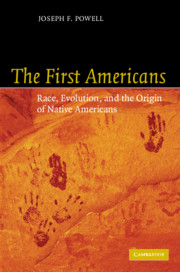Book contents
- Frontmatter
- Contents
- Acknowledgments
- Prologue: The Kennewick controversy
- PART I Race and variation
- PART II The Pleistocene peopling of the Americas
- 5 The Pleistocene and ice-age environments
- 6 Ancient cultures and migration to the Americas
- 7 Kennewick Man and his contemporaries
- 8 Human variation in the Pleistocene
- PART III The First Americans, race and evolution
- References
- Index
5 - The Pleistocene and ice-age environments
Published online by Cambridge University Press: 21 August 2009
- Frontmatter
- Contents
- Acknowledgments
- Prologue: The Kennewick controversy
- PART I Race and variation
- PART II The Pleistocene peopling of the Americas
- 5 The Pleistocene and ice-age environments
- 6 Ancient cultures and migration to the Americas
- 7 Kennewick Man and his contemporaries
- 8 Human variation in the Pleistocene
- PART III The First Americans, race and evolution
- References
- Index
Summary
WHEN AND WHAT IS THE PLEISTOCENE?
The Pleistocene geological epoch began 1.8 million years ago (mya) and is the geological period directly following the Pliocene (1.8–5.2 mya), the epoch in which all hominids and hominins evolved. For most of the Pleistocene, ice sheets and glaciers covered the Earth's major land masses. Within this epoch are several “stadials,” or cooling events, when glaciers and ice sheets expanded their ranges.
The cold stadials are separated long warming periods, or interglacials. In the most recent interstadial, today's Holocene Epoch, there were stadial-like cooling periods – short, abrupt returns to ice-age conditions, the most significant and recent being the Older (13,840–13,590 yr BP) and Younger Dryas (12,680–11,560 yr BP). During these cooling periods, average global temperatures decreased rapidly by 2–5°C (Straus, 1996). The end of the Pleistocene, or “terminal Pleistocene,” was the time of a huge global warming event (the Holocene) that thus far has lasted for the past 12,000 years. All through the Pleistocene, huge sheets of ice covered Europe and Asia. Two large ice sheets also covered the majority of North America: these were called the Laurentide and Cordilleran sheets. The Laurentide sheet was centered over present-day Hudson Bay in Canada, while the Cordilleran was a west coast ice sheet extending down from the western mountains of Alaska and Canada (British Columbia and Saskatchewan) to the present-day Sierra Nevadas in northern California, and Nevada to the Pacific shore.
- Type
- Chapter
- Information
- The First AmericansRace, Evolution and the Origin of Native Americans, pp. 103 - 113Publisher: Cambridge University PressPrint publication year: 2005



